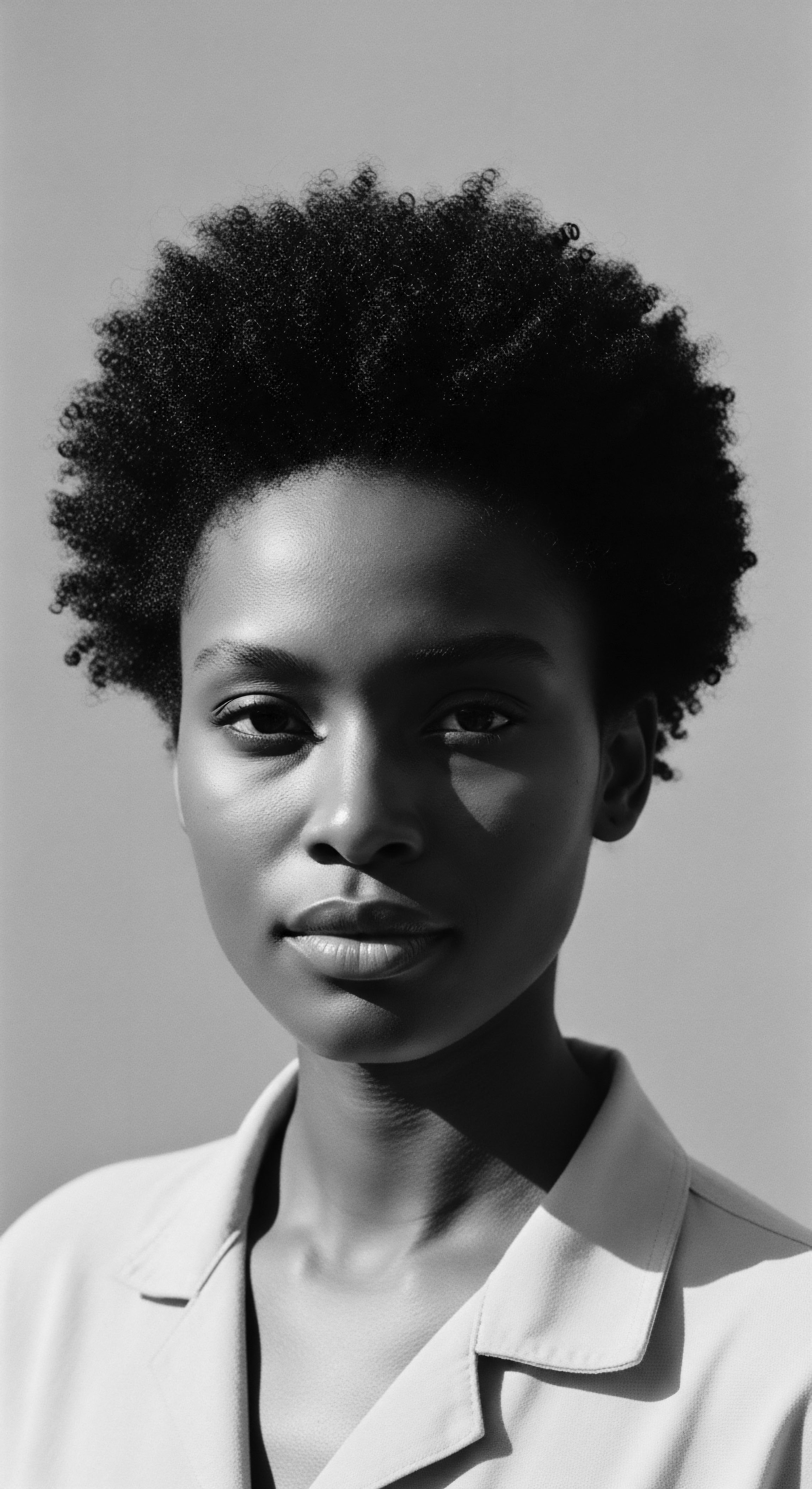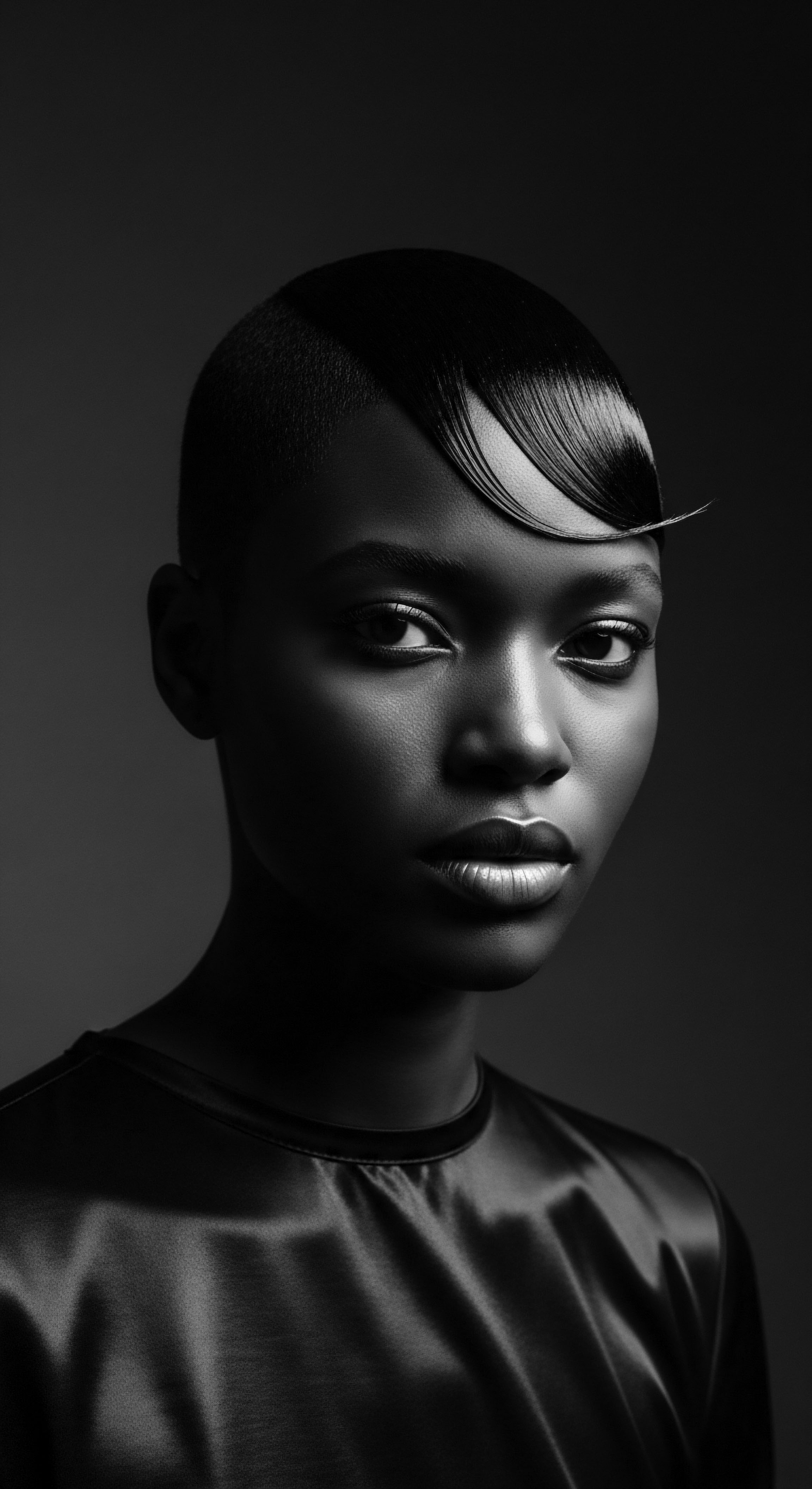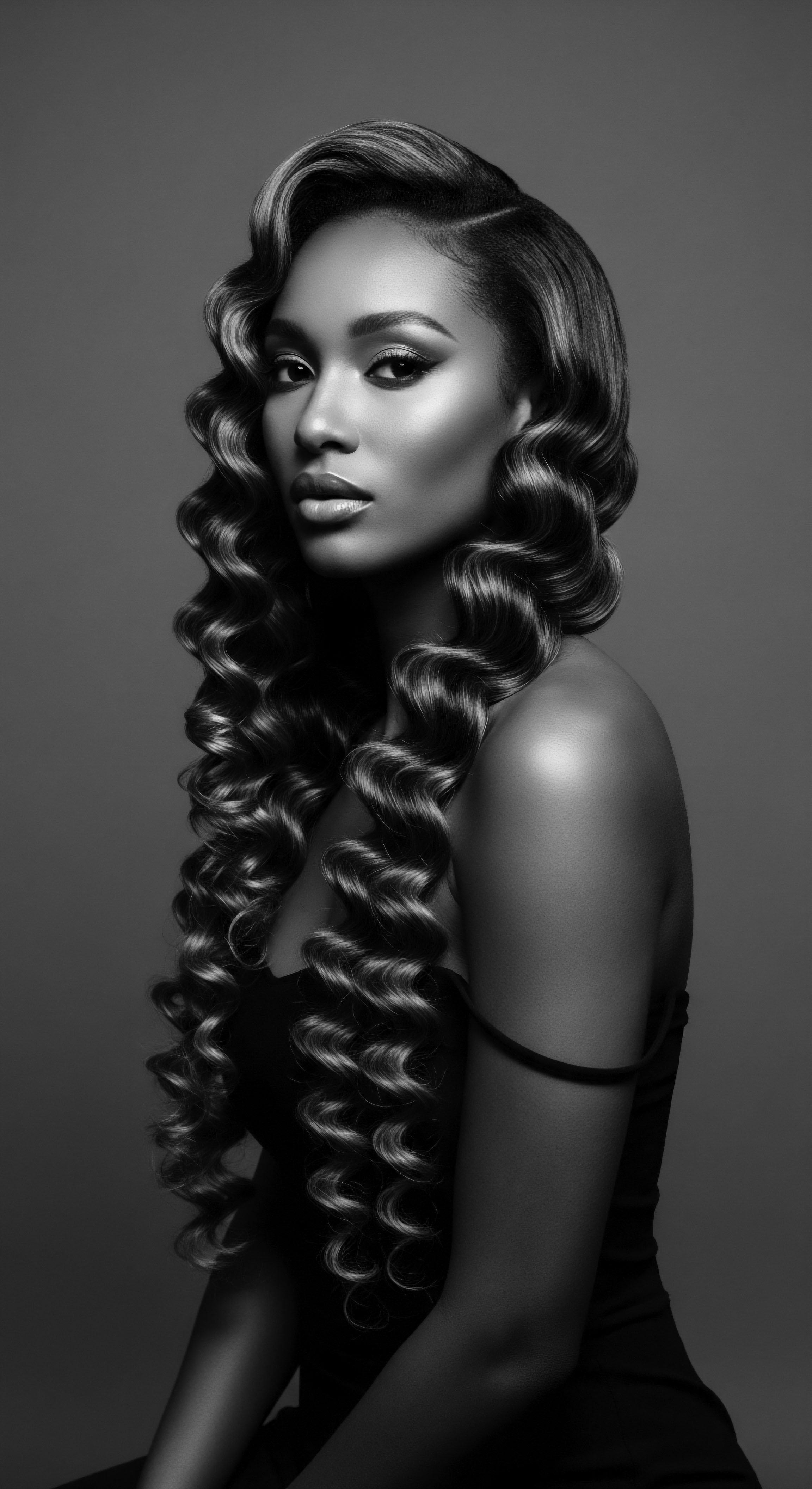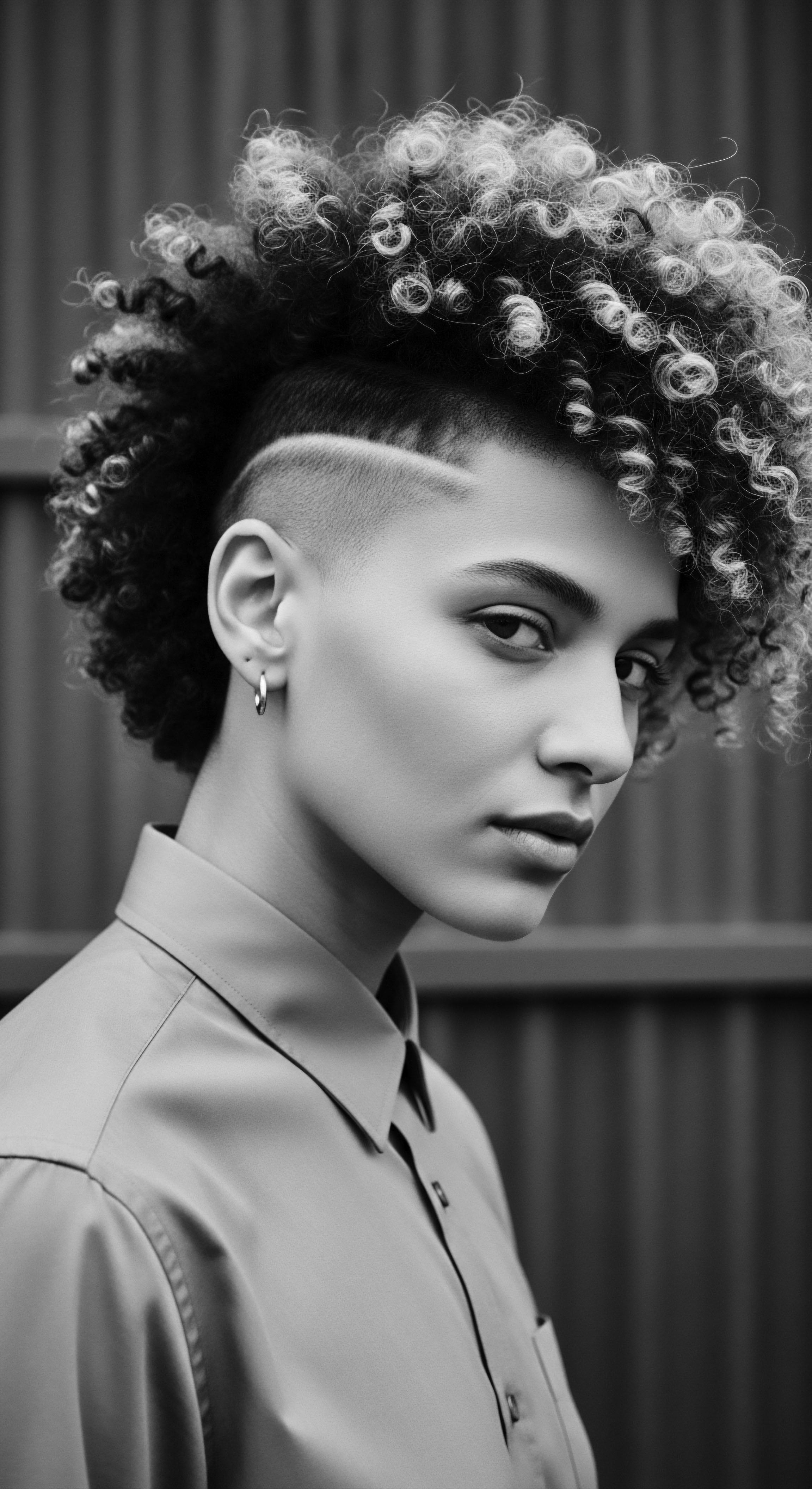
Fundamentals
The concept of Natural Greens, when viewed through the lens of textured hair heritage, delineates the profound and elemental connection between Earth’s botanical offerings and the enduring vitality of hair, particularly within Black and mixed-race communities. It describes a continuum of care, stretching back through ancestral time, wherein the living plant world provided the fundamental tools for nurturing coils, kinks, and waves. Natural Greens speaks to the very origins of hair wellness, far predating modern chemical formulations, by focusing on remedies sourced directly from the soil and foliage.
This perspective acknowledges that the Earth, in its profound wisdom, has always held the keys to hair health. These are not merely ingredients; they represent a philosophy of stewardship, a reciprocal relationship with the land that has sustained generations. From the vibrant leaves yielding rich infusions to the mucilaginous properties hidden within humble pods, Natural Greens provided ancestral communities with practical and effective solutions for maintaining the inherent resilience of textured strands. This approach offers a gentle wisdom, guiding us toward practices that honor both our bodies and the planet.
Natural Greens refers to the Earth’s botanical provisions and the holistic ancestral practices employed to nurture textured hair, fostering vitality and a deep connection to heritage.
Across diverse regions where textured hair has flourished, early methods of hair care often centered on what was readily available from nature’s embrace. Communities relied on their intimate knowledge of local flora to address common needs like cleansing, conditioning, and scalp health. The careful selection of plants, the thoughtful preparation of their extracts, and the ritualistic application formed the bedrock of hair traditions. These practices were often passed down through oral traditions, from elder to youth, ensuring that the wisdom of the Earth remained intertwined with personal grooming and communal identity.
These early approaches served as more than functional routines; they were integral to cultural expression, social cohesion, and spiritual well-being. The act of gathering and preparing these botanical elements for hair care reinforced a bond with the natural world and the collective ancestral memory. Hair, viewed as a sacred extension of self and lineage, received nourishment from the very earth from which life springs.

Gifts from the Earth ❉ Essential Botanicals
Many foundational plant-based components formed the core of ancestral hair care. These were chosen for their perceived properties, observed effects, and often, their energetic connection to the human body. The intuitive understanding of how these botanical gifts interacted with hair and scalp allowed for sophisticated systems of care to develop organically.
- Aloe Vera ❉ Its succulent leaves yield a clear gel, widely recognized for its soothing and hydrating qualities, often applied to the scalp to calm irritation or as a moisturizing treatment.
- Hibiscus ❉ The vibrant flowers of this plant, native to tropical Africa, were traditionally used to create infusions that nourish hair fibers, reduce frizz, and impart a healthy sheen.
- Yucca Root ❉ Indigenous tribes of North America utilized the root of the yucca plant as a natural cleansing agent, producing a gentle lather that effectively cleaned hair and scalp without stripping natural oils.
- Shea Butter ❉ Derived from the nuts of the shea tree in West Africa, this rich butter has been a staple for centuries, providing deep moisture and protection for textured hair against environmental rigors.
- Chebe Powder ❉ A traditional blend from the Sahel region of Africa, notably used by Basara women in Chad, this powder is revered for its ability to strengthen hair and promote length retention, often applied in a paste form.
- Moringa ❉ This nutrient-rich herb, with origins in Africa and Asia, contains vitamins and minerals that strengthen hair, help prevent shedding, and provide scalp nourishment.

Rooted in Tradition ❉ A Comparative Glance at Care
The contrast between traditional approaches rooted in Natural Greens and later, more industrialized methods, highlights a shift in the understanding of hair care. Ancestral practices placed emphasis on gentle, sustained nourishment and working with the hair’s natural inclinations, rather than against them.
| Aspect of Care Cleansing |
| Traditional Practice (Natural Greens) Plant-based lathers (e.g. yucca, African black soap), herbal infusions. |
| Mid-20th Century & Beyond (Industrialized) Sulfate-laden shampoos for vigorous lather, often stripping. |
| Aspect of Care Conditioning |
| Traditional Practice (Natural Greens) Natural oils (shea, coconut), plant mucilage (okra), herbal rinses. |
| Mid-20th Century & Beyond (Industrialized) Synthetic silicones and heavy emollients for immediate slip. |
| Aspect of Care Scalp Health |
| Traditional Practice (Natural Greens) Herbal remedies, cooling plant extracts, topical application of oils. |
| Mid-20th Century & Beyond (Industrialized) Treatments often addressing symptoms, less emphasis on holistic health. |
| Aspect of Care Length Retention |
| Traditional Practice (Natural Greens) Protective styling with natural elements, consistent moisture through plant butters/oils. |
| Mid-20th Century & Beyond (Industrialized) Chemical straightening, heat styling, leading to potential damage. |
| Aspect of Care The shift away from Natural Greens often meant a departure from methods attuned to hair's natural structure, inadvertently creating new challenges for textured hair. |
The enduring meaning of Natural Greens within hair care stems from its direct connection to sustainability and cultural autonomy. It underscores the profound wisdom held by generations who understood that the Earth provided everything necessary for robust, vital strands. This deep wisdom continues to guide those who seek genuine wellness for their hair, honoring a heritage of ingenuity and profound connection.

Intermediate
Moving beyond the foundational understanding, the intermediate exploration of Natural Greens reveals a more nuanced appreciation for its role in textured hair traditions. This deeper look considers not only the ingredients themselves but also the intricate web of human interaction, cultural transmission, and the inherent properties that made these botanical elements indispensable. The journey of Natural Greens in hair care, from the elemental biology of plants to their interwoven place in communal life, charts a remarkable path of knowledge and resilience.

Echoes from the Source ❉ Elemental Biology and Ancient Wisdom
The efficacy of Natural Greens lies within their elemental biology, a silent testament to ancestral observation and ingenious application. Our forebears possessed an intuitive scientific understanding, recognizing that certain plants offered specific benefits for hair and scalp. They discerned the presence of compounds that could cleanse without stripping, moisturize without residue, or stimulate growth with gentle persuasion. This ancient wisdom, often passed through oral narratives and lived practice, laid the groundwork for phytochemistry long before the term existed.
Consider the saponins found in plants like Soapwort or Yucca Root, which create a natural lather, dissolving impurities from the hair and scalp. Or the polysaccharides in aloe vera and okra, responsible for their characteristic mucilaginous texture, providing incredible slip and moisture for detangling. These bio-active compounds, patiently discovered and methodically applied over millennia, offered comprehensive care that respected the delicate structure of textured hair. The precise meaning of Natural Greens extends to this empirical, lived science, where observations of plant effects informed generations of practical hair knowledge.
Natural Greens embodies an ancient, intuitive phytochemistry, where ancestral communities discerned and harnessed specific plant compounds for holistic hair vitality.

The Tender Thread ❉ Living Traditions of Care and Community
The narrative of Natural Greens is inseparable from the communal rituals and intergenerational bonds that shaped hair care traditions. It was rarely a solitary act; instead, hair care often unfolded within a familial or community setting. This collective endeavor served as a powerful mechanism for transmitting knowledge, fostering connection, and reinforcing cultural identity. Grandmothers taught daughters, aunts guided nieces, and peers shared remedies, creating a living archive of wisdom.
In many West African societies, for example, the communal braiding sessions were not simply about styling; they were profound moments of storytelling, teaching, and shared resilience. Within these spaces, the application of various Natural Greens, such as shea butter or herbal infusions, transformed into a practice steeped in cultural meaning. The act of nurturing hair with these natural elements became a tangible link to heritage, a continuity of practice that bridged past, present, and future. The practical application of Natural Greens became an intimate act of love, passed from hand to hand, ensuring the survival of traditions against the tide of forced cultural erasure.

The Unbound Helix ❉ Identity, Resistance, and Adaptation
The meaning of Natural Greens also intertwines with themes of identity and resistance, particularly within the challenging historical contexts faced by Black and mixed-race communities. As external pressures often sought to devalue or suppress natural hair textures, the deliberate choice to employ ancestral remedies became an assertion of self and cultural pride. This conscious return to plant-based care signaled a reclamation of agency, a refusal to conform to imposed beauty standards.
Across the diaspora, from the Caribbean to the Americas, communities adapted their ancestral knowledge of Natural Greens to new environments, finding similar botanical substitutes or cultivating those they could. This adaptability underscores the enduring power of these practices as symbols of defiance and creativity. The continuous use of plant-derived ingredients speaks to an unbroken lineage of self-care, a profound statement that identity and heritage could survive, and indeed flourish, even in the harshest of circumstances. It represented a quiet, yet potent, form of resistance, affirming the beauty inherent in one’s natural state.

A Global Botanical Glossary ❉ Varieties of Natural Greens
The vast geographical reach of the African diaspora, combined with indigenous knowledge systems in various lands, contributed to a rich diversity of Natural Greens employed in textured hair care. Each region offered its own unique botanical treasures, often adapted to local ecosystems, yet united by a shared philosophy of natural reverence.
| Natural Green Okra (Abelmoschus esculentus) |
| Geographical Origin & Cultural Context West Africa, Ethiopia, African Diaspora (Caribbean, Americas) |
| Traditional Hair Care Application Mucilage used as a detangler, conditioner, and moisturizer for coils. |
| Natural Green Cassava (Manihot esculenta) |
| Geographical Origin & Cultural Context West Africa, Caribbean, South America |
| Traditional Hair Care Application Starch used in hair masks for strengthening and cleansing, sometimes fermented. |
| Natural Green Moringa (Moringa oleifera) |
| Geographical Origin & Cultural Context Africa, India, Asia |
| Traditional Hair Care Application Oil from seeds and leaf powder used for strengthening, nourishing scalp, and growth. |
| Natural Green Guava Leaf (Psidium guajava) |
| Geographical Origin & Cultural Context Jamaica, Caribbean, Latin America |
| Traditional Hair Care Application Leaves steeped to create a rinse believed to reduce hair shedding and strengthen strands. |
| Natural Green Rosemary (Rosmarinus officinalis) |
| Geographical Origin & Cultural Context Mediterranean, adapted globally, used in various diaspora traditions |
| Traditional Hair Care Application Infusions used to stimulate scalp circulation and promote hair growth. |
| Natural Green Leaf of Life (Kalanchoe pinnata) |
| Geographical Origin & Cultural Context Jamaica, Caribbean, West Africa |
| Traditional Hair Care Application Juice or blended leaves used as a scalp treatment for various ailments, promoting regrowth. |
| Natural Green These examples highlight the diverse botanical knowledge passed through generations, illustrating the adaptive nature of ancestral hair care. |
The exploration of Natural Greens at an intermediate level encourages us to appreciate the depth of knowledge held within these historical practices. It invites reflection on how the connection to nature and community shaped not only hair health but also the very fabric of identity and continuity for individuals and collectives with textured hair. The enduring power of these traditions continues to shape modern natural hair movements, serving as a reminder of the timeless wisdom embedded in the earth’s offerings.

Academic
The precise definition of Natural Greens, from an academic and expert-level perspective, extends beyond mere botanical ingredients to encompass a complex interplay of ethnobotanical science, cultural anthropology, and the lived historical experience of Black and mixed-race communities. It represents a synergistic system of care, where indigenous knowledge of plant properties, ritualistic application, and communal transmission converge to sustain and celebrate textured hair. The meaning of Natural Greens, therefore, is rooted in its demonstrable efficacy, its profound cultural significance, and its role as a persistent symbol of resilience and self-determination across the African diaspora.
This conceptualization acknowledges that the relationship between textured hair and its environment is not incidental; it is a meticulously observed and adapted symbiosis. The profound understanding of plant biochemistry, although uncodified in modern scientific terms, was embedded within ancestral practices, guiding the selection and preparation of flora to address the unique structural and physiological needs of coily, kinky, and wavy strands. This deep wisdom, passed through generations, constitutes a comprehensive approach to hair health, distinguishing Natural Greens from any superficial trend.

The Definitive Meaning of Natural Greens ❉ A Holistic Delineation
Natural Greens, within the context of textured hair heritage, designates the corpus of plant-derived substances and the associated ancestral methodologies purposefully employed for the cleansing, conditioning, strengthening, and adornment of hair, fundamentally impacting its phenotypic expression and cultural symbolism. This encompasses both the tangible botanical materials—such as leaves, barks, seeds, roots, and their extracts—and the intangible cultural processes, including intergenerational knowledge transfer, community rituals, and acts of personal and collective identity affirmation. The significance of Natural Greens lies in its capacity to foster optimal hair health by working in congruence with the inherent structure of textured strands, while simultaneously serving as a material anchor to lineage, resisting historical pressures of assimilation and aesthetic subjugation. Its continuous practice stands as a testament to the scientific ingenuity and cultural fortitude embedded within Black and mixed-race hair traditions.

Echoes from the Source ❉ Phytochemistry and Ancestral Observance
The scientific underpinning of Natural Greens rests upon the intricate phytochemistry of plants, a domain intuitively grasped by ancestral communities. For instance, the understanding of Saponins—naturally occurring glycosides that produce a foam when agitated in water—was not merely theoretical but practical. Indigenous peoples, long before the advent of industrial surfactants, harnessed plants like Yucca (Yucca schidigera) for their cleansing properties.
Yucca root, when crushed and infused, releases these saponins, creating a gentle yet effective lather capable of lifting dirt and oils without stripping the hair’s vital moisture. This illustrates a sophisticated empirical knowledge of plant compounds and their interactions with biological substrates, demonstrating a form of applied phytochemistry.
Furthermore, the mucilaginous exudates from certain plants offer a prime example of Nature’s inherent conditioning agents. These complex polysaccharides, upon hydration, form a slippery, viscous gel that coats hair strands, reducing friction and enhancing detangling. The careful observation of such properties led to the integration of ingredients like Okra Mucilage (from Abelmoschus esculentus) into daily hair rituals across West Africa and its diaspora.
This practice reveals an early understanding of polymer science and its application to hair manageability, directly addressing the unique coiling patterns of textured hair that are prone to knotting and breakage when dry. The persistent meaning of these practices lies in their adaptive intelligence, responding directly to the biophysical characteristics of textured hair.
This profound awareness extended to ingredients rich in vitamins, minerals, and antioxidants, recognizing their role in nourishing the scalp and strengthening hair follicles. The use of leaves and flowers from plants such as Hibiscus (Hibiscus sabdariffa), often prepared as infusions or pastes, provided a bio-available source of compounds that contribute to hair elasticity, shine, and overall resilience. These practices underscore a deep, holistic view of hair health, recognizing its interdependence with the vitality of the body and the environment.
Ancestral engagement with Natural Greens represents a sophisticated, empirically derived understanding of botanical compounds and their nuanced benefits for textured hair.

The Tender Thread ❉ Diasporic Continuity and Knowledge Transmission
The transmission of knowledge concerning Natural Greens is a compelling narrative of cultural continuity, particularly pronounced throughout the African diaspora. When forcibly displaced during the transatlantic slave trade, enslaved Africans were stripped of their material possessions, yet they carried within them an invaluable inheritance ❉ the knowledge of their ancestral hair practices and the botanical remedies that sustained them. This historical rupture compelled a remarkable act of adaptation and synthesis, as communities sought out similar plants in new lands or innovated with available resources, keeping the tender thread of heritage intact.
A potent, albeit less commonly highlighted, example of this resilient transmission involves the sustained use of Okra Mucilage in textured hair care across West Africa and its diasporic communities. While okra (Abelmoschus esculentus) is widely known as a culinary staple, its historical and ongoing application as a hair conditioning and detangling agent offers significant insight into the adaptive ingenuity inherent in Natural Greens practices. Ethnobotanical studies on traditional West African agricultural systems, for instance, detail the multipurpose utility of various Abelmoschus species, including their use beyond food in traditional medicine and self-care. The viscoelastic properties of okra’s mucilage, primarily composed of polysaccharides, have been scientifically evaluated to provide excellent slip and moisture retention, mirroring the effects of modern conditioners.
Despite the devastation of forced migration, this specific application of okra for hair persisted. In communities across the Caribbean, parts of South America, and the Southern United States, where okra was introduced and cultivated, the knowledge of preparing its pods for hair-softening rinses and gels was carefully preserved through oral tradition. This was not merely a convenient substitute; it was a testament to a deeply embedded scientific understanding passed down from mother to daughter, from elder to youth, ensuring that the unique needs of kinky and coily textures continued to be met with nature’s provision.
One could look to the historical continuity of such practices, noting how the preparation of okra mucilage for hair care has been observed in communities in present-day Nigeria (where Abelmoschus caillei also grows) and among Afro-Caribbean populations, illustrating a living legacy of hair wellness. This unbroken chain of knowledge, often through direct instruction during communal hair-braiding or styling sessions, acted as a silent resistance against the imposed uniformity of Eurocentric beauty ideals and the concomitant denigration of natural Black hair.

The Unbound Helix ❉ Identity, Resistance, and Reclamation
The choice to utilize Natural Greens for textured hair transcends simple cosmetic preference; it functions as a profound act of identity and cultural reclamation. Throughout periods of systematic oppression, when African-descended hair was often pathologized and deemed “unmanageable” or “unprofessional,” adhering to ancestral care practices became a quiet yet potent form of dissent. The natural hair movement, blossoming across various eras, draws directly from this historical wellspring, asserting the inherent beauty and dignity of textured hair in its unadulterated state.
The deliberate engagement with Natural Greens, in this context, is a conscious re-connection to a lineage of resilience. It serves as a rejection of homogenizing beauty standards that historically promoted chemical alteration and heat manipulation of textured hair, often leading to damage and disconnection from one’s biological heritage. By returning to plant-based cleansers, deep conditioners crafted from botanicals, and protective styles nourished by earth-derived butters, individuals re-affirm their ancestral ties and embrace a more authentic expression of self. This practice fosters a sense of embodied history, where each strand becomes a living testament to generations of ingenuity and pride.
The long-term implications of this reclamation are significant, extending beyond individual hair health to broader socio-cultural dynamics. It contributes to a re-evaluation of beauty standards, promoting diversity and self-acceptance. Moreover, it stimulates renewed interest in ethnobotanical research, validating ancestral knowledge through contemporary scientific inquiry. This movement strengthens economic opportunities within communities, as small businesses centered on traditionally inspired, natural hair care products gain prominence.
The continuous re-discovery and application of Natural Greens in textured hair care thus signifies not merely a return to traditional ways, but a dynamic evolution, forging a future where heritage and wellness are inextricably intertwined. The collective act of celebrating these practices helps to dismantle systemic biases and fosters a profound respect for the diversity of human hair.
The enduring meaning of Natural Greens, viewed through this academic lens, is its holistic capacity to integrate biological efficacy with deep cultural meaning. It stands as a living testament to human adaptability, the wisdom of indigenous societies, and the unyielding spirit of those who have consistently honored their ancestral roots through the tender care of their hair. This profound connection is more than a historical footnote; it is a vital, ongoing narrative of empowerment and continuity.

Reflection on the Heritage of Natural Greens
Our journey through the terrain of Natural Greens has revealed far more than a collection of plant-based ingredients; it has uncovered a living, breathing archive of human ingenuity, cultural resilience, and profound connection to the natural world. From the subtle echoes of ancient botanical wisdom, through the tender threads of communal care, to the unbound helix of identity, Natural Greens speaks to a heritage that is as vital and adaptable as the very strands it nurtures. It is a testament to the enduring power of ancestral knowledge, a wisdom whispered through generations, affirming that all we truly need often resides within the Earth’s generous embrace.
The practices surrounding Natural Greens are not relics of a forgotten past; they are enduring rhythms that resonate in the present, continuing to shape the lives of individuals with textured hair across the globe. Each application of a plant-derived essence, each communal styling session, carries the weight and grace of centuries, re-affirming a bond to lineage and a profound respect for the inherent beauty of one’s natural state. It is a soulful dance between self-care and historical consciousness, where the act of tending to one’s hair becomes an honoring of those who came before.
In an accelerating world, the timeless wisdom embedded in Natural Greens offers a grounding presence. It invites us to slow down, to listen to the silent language of plants, and to re-connect with rhythms that honor the holistic well-being of both hair and spirit. The narrative of Natural Greens, ever evolving, continues to voice the identity of textured hair, shaping a future where its rich heritage is celebrated, cherished, and forever unbound. This is the enduring meaning of the “Soul of a Strand,” a vibrant continuum of care, consciousness, and profound connection.

References
- Adoum, N. G. (2018). Chebe ❉ The secrets of Chadian women for hair growth. International Journal of Advanced Research, 6 (8), 51-54.
- Byrd, A. D. & Tharps, L. (2014). Hair Story ❉ Untangling the Roots of Black Hair in America. St. Martin’s Press.
- Johnson, A. (2005). Spirit and Beauty ❉ A Cross-Cultural Look at Hair in African American and African Cultures. University of Georgia Press.
- Kennedy, J. D. (1971). Some Indigenous African Hair Practices ❉ An Ethnobotanical Study. Journal of Ethnobotany and African Studies.
- Obeng, E. (2000). Medicinal Plants of Ghana. Ghana Universities Press.
- Osawaru, M. E. & Dania-Ogbe, F. M. (2010). Ethnobotanical Studies of West African Okra from Some Tribes of South Western Nigeria. American-Eurasian Journal of Scientific Research, 5 (1), 16-21.
- Palmer, S. (2001). Hair ❉ A Cultural History. Pavilion.
- Poucher, W. A. (1941). Perfumes, Cosmetics and Soaps. Chapman & Hall.
- Sowunmi, M. A. (2004). The significance of traditional African hair styles. Journal of Pan African Studies, 8 (3), 101-118.
- Villa, P. et al. (2015). A 49,000-year-old ochre-and-milk paint from Sibudu Cave, South Africa. PLOS One, 10 (6), e0132332.
